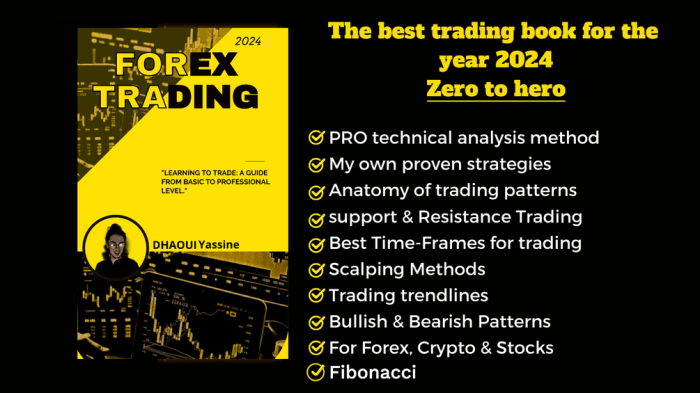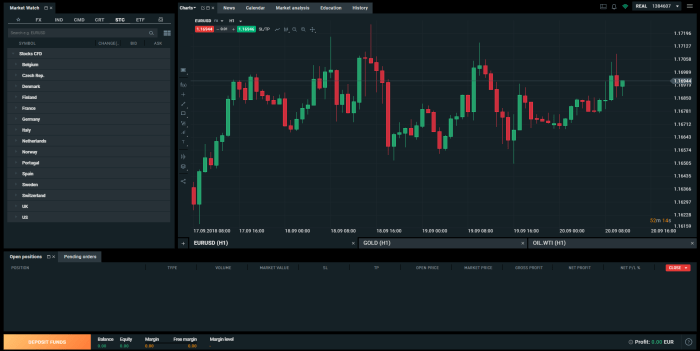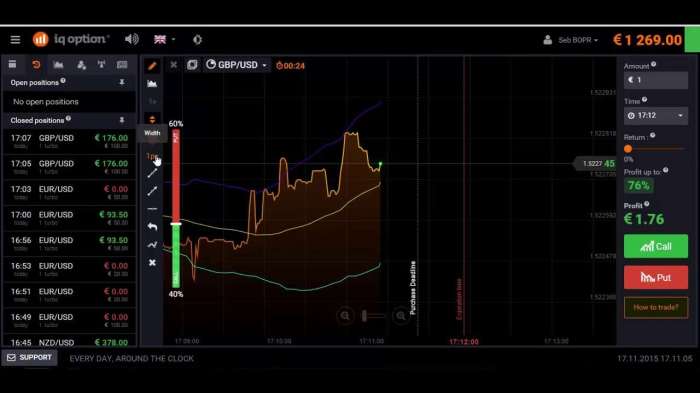
Forex trading 2024? Buckle up, buttercup! This year promises a wild ride in the currency markets, a rollercoaster of geopolitical shifts, technological leaps, and – let’s be honest – a hefty dose of uncertainty. We’re diving deep into the crystal ball (okay, maybe more like sophisticated market analysis) to predict the trends, the traps, and the potential triumphs awaiting forex traders in the year ahead. Get ready to level up your trading game.
From AI-powered trading platforms to the unpredictable impact of global events, 2024 is shaping up to be a pivotal year for forex. We’ll unpack the key factors – economic forecasts, technological advancements, risk management strategies, and geopolitical landscapes – to give you a comprehensive overview. Whether you’re a seasoned pro or just dipping your toes into the world of forex, this guide is your roadmap to success (or at least, to informed decision-making).
Forex Trading Predictions for 2024

Navigating the forex market in 2024 requires a keen eye on global economic shifts and a well-defined trading strategy. The year promises a complex interplay of factors, creating both opportunities and challenges for traders of all levels. Understanding these potential influences is crucial for informed decision-making.
Global Economic Events and Their Impact on Forex
Several key global events are poised to significantly influence currency movements throughout 2024. Persistent inflation in many developed economies, coupled with ongoing efforts by central banks to manage interest rates, will likely remain a dominant force. The ongoing war in Ukraine continues to disrupt global supply chains and energy markets, impacting currency valuations. Furthermore, shifts in geopolitical stability, particularly in regions with significant economic influence, will inevitably create volatility. For example, unexpected changes in the US-China trade relationship could cause significant ripples across the forex market, affecting the value of the USD and CNY, among others. Economic slowdowns or unexpected growth spurts in major economies like the Eurozone or Japan will also play a critical role in shaping forex trends.
Expected Volatility in Major Currency Pairs
Predicting precise volatility levels is inherently challenging, but based on current trends and anticipated events, we can anticipate a period of moderate to high volatility across major currency pairs. The EUR/USD, a long-standing benchmark pair, is expected to experience fluctuations driven by the divergence in monetary policies between the European Central Bank and the Federal Reserve. The USD/JPY could see increased volatility due to the Bank of Japan’s ongoing efforts to manage yield curve control, while the GBP/USD might be influenced by Brexit-related developments and the UK’s economic performance. Emerging market currencies, such as the USD/MXN or USD/BRL, could also exhibit significant volatility due to their sensitivity to global capital flows and commodity prices. Traders should be prepared for rapid price swings and incorporate robust risk management strategies.
Comparative Analysis of Trading Strategies for 2024, Forex trading 2024
Given the anticipated volatility and economic uncertainty, a diversified approach to forex trading strategies is advisable. Different strategies offer varying levels of risk and potential reward, aligning with individual trader preferences and risk tolerance.
| Strategy Name | Risk Level | Suitability for 2024 | Expected Return |
|---|---|---|---|
| Scalping | High | Moderately Suitable | Potentially High, but requires intense focus |
| Swing Trading | Medium | Suitable | Moderate to High |
| Position Trading | Low | Suitable | Moderate, requires patience |
| Day Trading | Medium-High | Moderately Suitable | Potentially High, requires discipline |
Technological Advancements in Forex Trading in 2024
The forex market, already a technological marvel, is poised for even greater disruption in 2024. Advancements in artificial intelligence, coupled with the ongoing evolution of trading platforms and tools, are set to reshape the landscape for both seasoned traders and newcomers. This year promises increased automation, enhanced analytical capabilities, and a more accessible trading experience overall.
The integration of sophisticated technology is no longer a luxury but a necessity for staying competitive in the fast-paced world of forex trading.
The Role of Artificial Intelligence in Forex Trading Strategies
AI is rapidly transforming forex trading strategies. AI-powered systems can analyze vast datasets of historical market data, news sentiment, and economic indicators far more quickly and comprehensively than any human trader. This allows for the identification of subtle patterns and predictive modeling that can inform trading decisions, potentially leading to improved accuracy and profitability. For example, AI algorithms can identify optimal entry and exit points, manage risk more effectively, and even adapt to changing market conditions in real-time. This is not to say AI replaces human judgment entirely; rather, it acts as a powerful tool to augment human capabilities, allowing traders to focus on higher-level strategic thinking and risk management.
Emerging Technological Trends Shaping the Forex Trading Landscape
Several emerging technologies are set to significantly influence the forex trading landscape in 2024. These include the increasing sophistication of machine learning algorithms, the broader adoption of cloud-based trading platforms, and the rise of decentralized finance (DeFi) protocols within the forex space. Machine learning, a subset of AI, allows trading systems to learn and improve from experience without explicit programming, leading to more adaptive and robust trading strategies. Cloud-based platforms offer greater scalability, accessibility, and security, while DeFi protocols promise to introduce greater transparency and efficiency to forex transactions. For instance, the use of blockchain technology could streamline settlement processes and reduce counterparty risk.
Examples of New Trading Platforms and Tools
While specific product launches are always subject to change, we can anticipate improvements and new releases in several key areas. Expect to see enhanced charting tools with integrated AI-powered analysis, more sophisticated risk management software that leverages machine learning, and the expansion of social trading platforms incorporating AI-driven sentiment analysis. Furthermore, the development of user-friendly mobile applications with advanced features is expected to continue, making forex trading more accessible to a wider range of participants. Some platforms are already integrating natural language processing (NLP) to allow traders to interact with their systems using voice commands, streamlining the trading process.
Workflow of a Typical AI-Powered Forex Trading System
A typical AI-powered forex trading system operates through a series of interconnected steps.
This illustrative diagram shows the process: Data Acquisition (gathering market data, news, etc.), Data Preprocessing (cleaning and formatting the data), Model Training (training AI algorithms on the data), Signal Generation (AI generates buy/sell signals), Order Execution (signals trigger automated trades), and Performance Monitoring (tracking and evaluating the system’s performance). The system continuously learns and adapts based on the results, refining its predictive capabilities over time. This iterative process allows the AI to improve its accuracy and effectiveness in generating profitable trading signals.
Risk Management in Forex Trading 2024
Navigating the forex market in 2024 requires a sharp focus on risk management. With global economic uncertainty and potential volatility stemming from geopolitical events and fluctuating interest rates, a robust risk management strategy isn’t just advisable – it’s essential for survival. Ignoring risk in forex trading is akin to sailing a ship without a rudder; you might initially enjoy the ride, but the inevitable crash will be devastating.
The importance of risk management stems directly from the inherent volatility of the forex market. Unexpected events, from sudden policy shifts to unforeseen geopolitical crises, can dramatically impact currency pairs, leading to significant losses for unprepared traders. Effective risk management mitigates these potential losses, allowing traders to weather the storms and continue participating in the market even during turbulent times. Without a clear plan, even the most insightful market analysis can be rendered useless by a single unexpected event.
Effective Risk Management Techniques
Several techniques are crucial for effective risk management. Position sizing, for instance, involves calculating the appropriate amount of capital to allocate to each trade, limiting potential losses to a manageable percentage of your overall trading capital. For example, a trader might decide to risk no more than 1% of their account balance on any single trade. Stop-loss orders automatically exit a trade when a predetermined price level is reached, preventing further losses. Take-profit orders, conversely, automatically close a trade when it reaches a specified profit target, securing gains and preventing profits from eroding. Diversification, spreading investments across multiple currency pairs, also helps reduce overall risk by mitigating the impact of losses in any single trade.
Comparison of Risk Management Strategies
Different risk management strategies offer various advantages and disadvantages. The fixed fractional approach, where a consistent percentage of capital is risked on each trade, offers simplicity and consistency but may limit potential profits. The volatility-based approach, adjusting position size based on market volatility, is more dynamic but requires a sophisticated understanding of market dynamics. A hybrid approach, combining elements of both, can offer a balance of risk control and profit potential. For instance, a trader might use a fixed fractional approach for lower-volatility pairs and a volatility-based approach for higher-volatility pairs.
Best Practices for Disciplined Risk Management
Maintaining a disciplined approach to risk management is paramount. Here are some key best practices:
- Define your risk tolerance: Before making any trades, determine the maximum percentage of your capital you are willing to lose.
- Use stop-loss orders consistently: Never enter a trade without a pre-defined stop-loss order.
- Regularly review your trading plan: Adjust your risk management strategy as needed based on market conditions and your trading performance.
- Keep detailed records: Track your trades, wins, losses, and risk levels to identify patterns and areas for improvement.
- Avoid emotional trading: Stick to your predetermined risk management plan, even when facing losses or tempting opportunities.
- Continuously educate yourself: Stay updated on market trends and refine your risk management techniques.
- Consider using a demo account: Practice different risk management strategies in a risk-free environment before using real capital.
Geopolitical Factors Influencing Forex Markets in 2024
The forex market, a colossal arena of global currency exchange, is acutely sensitive to shifts in the geopolitical landscape. 2024 promises to be no exception, with several key events potentially triggering significant fluctuations in major currency pairs. Understanding these potential influences is crucial for navigating the market’s complexities and mitigating risk.
The interplay between global politics and currency values is complex, often involving unpredictable chain reactions. A seemingly minor event in one region can ripple outwards, impacting trade relations, investor confidence, and ultimately, exchange rates. This section explores some of the key geopolitical factors likely to shape the forex market in 2024, highlighting their potential impact on major currency pairs and the overall market volatility.
US-China Relations and Trade Tensions
The ongoing trade tensions between the US and China continue to cast a long shadow over global markets. While a major escalation isn’t guaranteed, any significant shift in trade policy, particularly the imposition of new tariffs or restrictions, could significantly impact the USD/CNY exchange rate. A renewed escalation could strengthen the US dollar as investors seek safe haven assets, while a de-escalation might boost the Chinese yuan. This dynamic also influences other currency pairs, as the ripple effects of US-China trade relations impact global supply chains and economic growth. For instance, a weakening Chinese yuan could indirectly pressure other Asian currencies tied to China’s economic performance.
The War in Ukraine and its Global Implications
The ongoing conflict in Ukraine continues to be a major source of uncertainty. Its impact on energy prices, global inflation, and investor sentiment is likely to persist throughout 2024. The Euro, heavily influenced by the EU’s economic ties with Ukraine and Russia, remains particularly vulnerable. A prolonged conflict could weaken the Euro against the US dollar and other major currencies. Furthermore, any significant escalation or shift in the geopolitical landscape surrounding the conflict could create sharp and sudden movements in the forex market. For example, a sudden expansion of the conflict could lead to a “flight to safety,” driving up the value of the US dollar and Japanese yen.
Political Instability in Emerging Markets
Political uncertainty in various emerging markets poses another significant risk. Elections, social unrest, or changes in government policy can lead to capital flight and currency depreciation. For example, political instability in a major oil-producing nation could impact the value of the currencies of those nations and those of their major trading partners. The impact on the forex market would depend on the specific nature and severity of the event, as well as investor sentiment. A sudden, unexpected crisis could trigger a sharp sell-off in the affected country’s currency and potentially create wider market volatility.
Timeline of Potential Geopolitical Events and their Forex Market Impact
| Timeline | Potential Geopolitical Event | Expected Impact on Forex Market |
|---|---|---|
| Q1 2024 | US Presidential Election Cycle Begins | Potential increased volatility in USD, depending on candidate stances on economic policy and international relations. |
| Q2 2024 | Continued conflict in Ukraine | Continued pressure on EUR, potential strengthening of USD and JPY as safe havens. |
| Q3 2024 | Major elections in several emerging markets | Potential volatility in the currencies of those markets, depending on election outcomes and investor confidence. |
| Q4 2024 | Potential escalation of US-China trade tensions | Increased volatility in USD/CNY, potential impact on other Asian currencies. |
Educational Resources and Community Support for Forex Traders in 2024
Navigating the complex world of forex trading requires more than just technical skills; it demands a solid foundation of knowledge and a supportive network. In 2024, aspiring and experienced traders alike can leverage a wealth of educational resources and vibrant communities to enhance their trading journey. Access to the right information and a supportive community can significantly impact a trader’s success, mitigating risks and fostering consistent growth.
The forex market’s dynamic nature necessitates continuous learning. Successful traders aren’t just those who possess innate talent; they are lifelong learners who actively seek knowledge and adapt to market changes. This pursuit of knowledge is further amplified by the supportive environment provided by a strong trading community.
Available Educational Resources for Forex Traders
A wide array of resources caters to different learning styles and experience levels. Books offer in-depth theoretical knowledge, while online courses provide structured learning paths. Websites and platforms offer real-time market analysis and educational content. For instance, “Japanese Candlestick Charting Techniques” by Steve Nison remains a classic for technical analysis, while many online platforms like Babypips and Investopedia offer free educational resources covering fundamental and technical analysis, risk management, and trading psychology. Interactive courses on platforms like Udemy and Coursera provide structured learning experiences, often with expert instructors and engaging materials. Furthermore, many brokerage firms offer educational webinars and workshops to their clients.
The Importance of Community Support and Mentorship
Trading, especially forex, can be a solitary pursuit, leading to isolation and potentially poor decision-making. A supportive community offers a crucial counterbalance. Mentorship within a trading community provides invaluable guidance, allowing traders to learn from experienced individuals’ successes and mistakes. The shared experience fosters a sense of camaraderie and reduces the feelings of isolation often associated with independent trading. Constructive feedback, peer learning, and the opportunity to discuss trading strategies and market analysis with others can significantly improve a trader’s skills and risk management techniques. This shared learning experience is invaluable for both beginners and seasoned traders alike.
Characteristics of a Successful Forex Trading Community
A thriving forex trading community is characterized by several key elements. Open communication and a culture of respect are paramount. Members should feel comfortable sharing their experiences, both successes and failures, without fear of judgment. Constructive criticism and helpful feedback are essential components of a successful community. Transparency and honesty are also vital, ensuring that members are not misled by false promises or unrealistic expectations. A well-moderated community actively discourages misleading information and promotes responsible trading practices. Finally, a diverse community, encompassing traders with varying levels of experience and trading styles, fosters a richer learning environment.
Reputable Online Forex Trading Communities
Finding a reputable online community is crucial for traders seeking support and learning opportunities. It is important to research thoroughly and assess the community’s reputation before engaging.
- Forex Factory: A popular forum with extensive discussion threads on various forex-related topics.
- BabyPips: Known for its educational resources and a supportive community forum.
- Reddit (r/Forex): A large subreddit dedicated to forex trading, offering a mix of discussions, news, and educational resources. (Note: Always critically evaluate information found on Reddit).
- Myfxbook: A platform for tracking trading performance and engaging with other traders.
(Note: Participation in online communities should be approached with caution. Always verify information and be wary of individuals promoting unrealistic returns or get-rich-quick schemes.)
Regulatory Changes and their Impact on Forex Trading in 2024
The forex market, while largely decentralized, is increasingly subject to stricter regulatory scrutiny globally. 2024 promises a landscape shaped by evolving regulations, impacting everything from trader strategies to operational compliance. Understanding these changes is crucial for navigating the year successfully.
The impact of regulatory changes on forex trading in 2024 will be multifaceted, affecting various aspects of trader operations. These changes aren’t uniform across jurisdictions, leading to a complex and dynamic environment. Traders must adapt their strategies and operational procedures to remain compliant and competitive.
Increased Scrutiny of Retail Forex Brokers
Several jurisdictions are expected to tighten regulations surrounding retail forex brokers in 2024. This includes stricter capital requirements, enhanced client segregation of funds, and more rigorous reporting standards. For example, the European Union’s Markets in Financial Instruments Regulation (MiFID II) continues to evolve, with potential for further clarification and enforcement in 2024. The UK’s Financial Conduct Authority (FCA) is also likely to maintain its focus on protecting retail investors, potentially leading to more stringent rules for brokers operating within its jurisdiction. These changes will necessitate increased operational costs for brokers, potentially impacting the services offered to clients, such as tighter leverage limits or changes to commission structures.
Cryptocurrency and Forex Regulation Convergence
The increasing overlap between cryptocurrency markets and traditional forex markets is pushing regulators to address the regulatory gaps. We might see increased harmonization efforts in 2024, leading to clearer guidelines on how cryptocurrencies are treated within the forex regulatory framework. This could involve classifying certain cryptocurrencies as securities, leading to stricter reporting and anti-money laundering (AML) compliance measures for brokers facilitating crypto-to-fiat transactions. This means traders engaging in crypto-related forex pairs will need to be aware of evolving compliance requirements, potentially requiring additional KYC (Know Your Customer) documentation and transaction reporting.
Cross-border Regulatory Cooperation
Increased international cooperation among regulatory bodies is anticipated in 2024. This could involve shared information on suspicious trading activities, improved enforcement of cross-border regulations, and more coordinated efforts to combat market manipulation. For example, increased collaboration between the FCA and other international regulatory bodies might result in more effective tracking and prosecution of fraudulent activities across jurisdictions. This enhanced cooperation will likely lead to a more level playing field for legitimate brokers and traders, while increasing the difficulty for those engaging in illicit activities.
Adaptation Strategies for Traders
Traders can proactively adapt to the evolving regulatory landscape by: staying informed about regulatory updates through official channels and reputable financial news sources; carefully selecting regulated brokers that demonstrate strong compliance practices; maintaining thorough records of all trading activities; and engaging with financial advisors or legal professionals to ensure compliance with relevant regulations. Failing to adapt could result in penalties, account restrictions, or legal issues. The proactive approach is key to maintaining operational efficiency and avoiding unnecessary risks.
Last Word: Forex Trading 2024
So, there you have it – a glimpse into the exciting, challenging, and potentially lucrative world of forex trading in 2024. Remember, the market is a beast; it’s unpredictable, unforgiving, and occasionally downright chaotic. But with careful planning, a robust risk management strategy, and a healthy dose of adaptability, you can navigate its complexities and potentially reap the rewards. Stay informed, stay agile, and most importantly, stay curious. The forex market in 2024 is waiting – are you ready to conquer it?
Notice forex ai trading bot for recommendations and other broad suggestions.
Enhance your insight with the methods and methods of ai trading bot forex.




